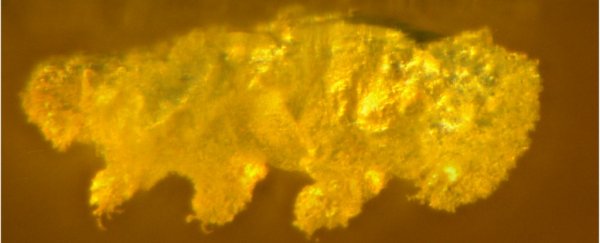A fossilized tardigrade found in Dominican amber constitutes a rare branch of the family tree for these weirdly indestructible beasties.
The specimen hails back to the Miocene, around 16 million years ago, and is only the third tardigrade preserved in amber to be fully described and named. Scientists say this scarcity is because they're so small, and their bodies don't produce minerals that survive the ages… and not because they just don't die, but who can say, really?
At any rate, the wee beastie, representing a new species, can help us fill in the evolutionary history of tardigrades, a phylum that somehow managed to survive every mass extinction we know of. Its discoverers have named it Paradoryphoribius chronocaribbeus, and identified it as a member of the modern tardigrade superfamily, Isohypsibioidea.
"The discovery of a fossil tardigrade is truly a once-in-a-generation event," says biologist Phil Barden of New Jersey Institute of Technology.
"What is so remarkable is that tardigrades are a ubiquitous ancient lineage that has seen it all on Earth, from the fall of the dinosaurs to the rise of terrestrial colonization of plants.
"Yet, they are like a ghost lineage for paleontologists with almost no fossil record. Finding any tardigrade fossil remains is an exciting moment where we can empirically see their progression through Earth history."
Tardigrades are remarkable survivors. When conditions get nasty, they can dry out, reconfigure their bodies and enter suspended animation – called desiccation – for years.
You can throw virtually anything at them: frozen temperatures, zero oxygen, high pressures, the vacuum of space, cosmic radiation, and being boiled, and even being fired out of a gun. Yet their evolutionary history is shrouded in mystery.
 So smol! (Phillip Barden/Harvard/NJIT)
So smol! (Phillip Barden/Harvard/NJIT)
The tiny, preserved tardigrade found in Dominican amber is microscopic, measuring just over half a millimeter in length. This was too small for the researchers to see with a normal dissecting microscope, so they turned to confocal microscopy.
The chitinous composition of a tardigrade's cuticle is easily excited by the lasers used in confocal microscopy, which means it fluoresces.
The result, the researchers say, is the best-imaged tardigrade fossil to date. In the images, they were clearly able to see the tardigrade's little claws, and its mouth apparatus, or foregut. This revealed that they were looking at something unknown.
"Even though externally it looked like a modern tardigrade, with confocal laser microscopy we could see it had this unique foregut organization that warranted for us to erect a new genus within this extant group of tardigrade superfamilies," says tardigradologist Marc Mapalo of Harvard University.
"Paradoryphoribius is the only genus that has this specific unique character arrangement in the superfamily Isohypsibioidea."
This also means that the scientists can better explore the evolutionary changes that tardigrades have undergone over a timespan of millions of years.
Paradoryphoribius represents the only tardigrade fossil from the current era, the Cenozoic. The other two are older: Milnesium swolenskyi, described in 2000, is from around 90 million years ago, and Beorn leggi, described in 1964, is from around 72 million years ago, both in the Mesozoic.
 (Mapalo et al., Proc. R. Soc. B, 2021)
(Mapalo et al., Proc. R. Soc. B, 2021)
Above: Autofluorescence of Paradoryphoribius chronocaribbeus under confocal microscopy.
Given the paucity of fossils, the discovery of even one gives us a wealth of information against which comparisons can be made. Even just by dating the amber, the team was able to place a minimum age on Isohypsibioidea.
"If you look at the external morphology of tardigrades, you might assume that there are no changes that occurred within the body of tardigrades," Mapalo said.
"However, using confocal laser microscopy to visualize the internal morphology, we saw characteristics that are not observed in extant species but are observed in the fossils.
"This helps us understand what changes in the body occurred across millions of years. Furthermore, this suggests that even if tardigrades may be the same externally, some changes are occurring internally."
The discovery also confirms that amber can serve as an untapped resource for tardigrade fossils. Because the animals tend to inhabit moist environments, where trees might be found, and because their tiny frames are not easily otherwise fossilized (or just live forever, who can say), amber seems like the best bet.
However, because they are so small, it's possible that tardigrade fossils in other amber deposits may have been overlooked.
The researchers hope that their discovery might inspire others to take a closer look at amber samples, in the hopes of learning more about this enigmatic, hardy phylum of animals.
"We are just scratching the surface when it comes to understanding living tardigrade communities, especially in places like the Caribbean where they've not been surveyed," Barden says.
"This study provides a reminder that, for as little as we may have in the way of tardigrade fossils, we also know very little about the living species on our planet today."
The research has been published in Proceedings of the Royal Society B: Biological Sciences.
